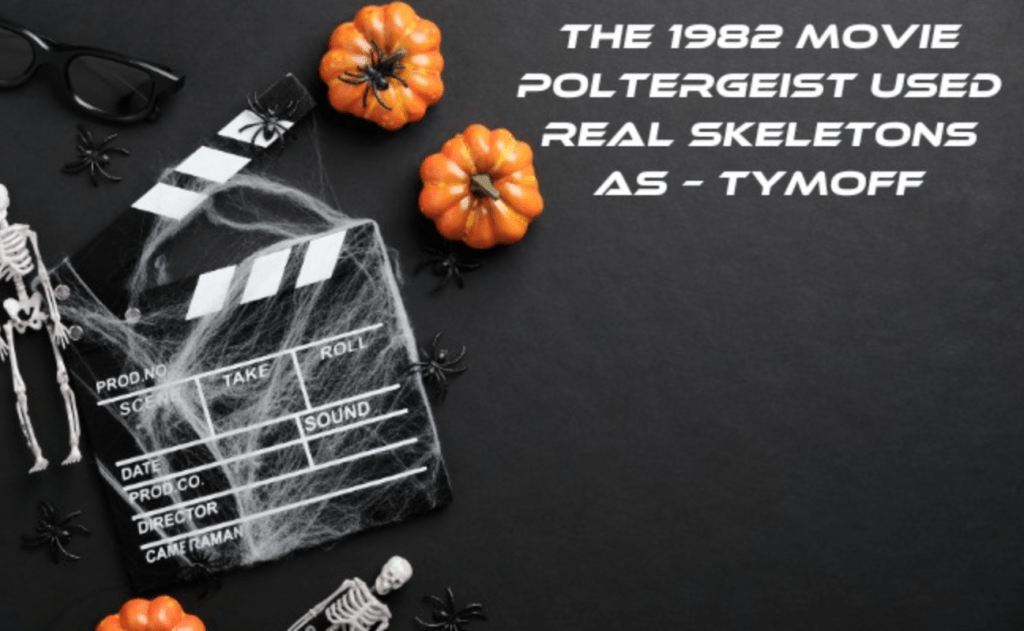Introduction To the 1982 movie poltergeist used real skeletons as – tymoff
At the point when we discuss exemplary blood and gore movies, Phantom from the 1982 movie poltergeist used real skeletons as – tymoff holds a unique spot in the hearts of fans. Coordinated by Tobe Hooper and created by Steven Spielberg, this film excited as well as left crowds with chills, somewhat because of a questionable choice: the utilization of genuine human skeletons.
Envision sitting serenely, popcorn close by, watching a thriller, just to find that a portion of its most frightening scenes were made with genuine human remaining parts. That is precisely exact thing occurred with Ghost. The film recounts the narrative of the Freeling family, who experience upsetting paranormal occasions in their home, yet in the background, there was a story comparably frightful.
The choice to utilize genuine skeletons was not messed with. It was a decision driven by common sense and spending plan limitations. At that point, getting plastic or elastic copies of human the 1982 movie poltergeist used real skeletons as – tymoff was more costly than utilizing the genuine article. This reality alone adds a layer of credibility and, truly, a to some degree disrupting perspective to the film’s as of now creepy climate.
JoBeth Williams, who played the person Diane Freeling, shared her experience, uncovering she was uninformed that the 1982 movie poltergeist used real skeletons as – tymoff encompassing her in the film’s climactic pool scene were authentic. Her acknowledgment, partook in interviews years after the fact, adds an individual and human component to the story, featuring the frequently mind boggling connection between the specialty of filmmaking and reality.
Table of Contents
The Scene That Shocked Audiences: Real Skeletons in Poltergeist
In Phantom, one scene specifically stands apart for its utilization of genuine human skeletons: when Diane Freeling, played by JoBeth Williams, falls into the family’s pool under development, just to end up encompassed by arising skeletons. This second isn’t just urgent for its shock esteem yet additionally for the way that it obscures the lines between the film’s imaginary repulsiveness and genuine frightfulness.
The choice to utilize genuine human remaining parts came from a commonsense outlook — genuine the 1982 movie poltergeist used real skeletons as – tymoffwere essentially more practical than their counterfeit partners. However, this decision made an imprint on crowds, cast, and team the same, implanting the film with an additional layer of legitimacy that couple of others have.
JoBeth Williams herself was one of the most vocal about the experience, communicating her inconvenience after learning the 1982 movie poltergeist used real skeletons as – tymoff. Her declaration adds an unmistakable feeling of disquiet, featuring the close to home and moral intricacies engaged with making a film that is intended to engage yet incidentally crosses into the domain of real unsettling influence.
The response to this disclosure has been blended, with a commending the film’s obligation to authenticity and others scrutinizing the ethical quality of involving human remaining parts in diversion. This discussion adds to the film’s inheritance, guaranteeing that it stays a subject of conversation and examination a long time after its delivery.
Why Did Poltergeist Use Real Skeletons?
the 1982 movie poltergeist used real skeletons as – tymoff was established in financial common sense as opposed to a craving to stun. At the hour of recording, genuine human skeletons were more affordable than top caliber, fake copies. This cost-saving measure says a lot about the entertainment world’s needs and difficulties during the mid 1980s, featuring when pragmatic impacts ruled, and computerized options were non-existent.
This decision, however determined by financial plan requirements, coincidentally added a layer of certifiable ghastliness to the film. It constrained the crowd to face the disrupting reality that the props utilized in their #1 awfulness scenes were once living individuals. This disclosure has started banters on the morals of involving human remaining parts for amusement, conversations that proceed right up to the present day.
Besides, the 1982 movie poltergeist used real skeletons as – tymoff carried a surprising profundity to the film. Realizing the skeletons are genuine can change how watchers experience the film, adding a layer of possibly unhealthy interest and disquiet that simply fictitious repulsiveness probably won’t accomplish.
Cast and Crew Reactions to the Real Skeletons
the 1982 movie poltergeist used real skeletons as – tymoff were utilized during the shooting of Ghost overwhelmed crowds as well as the cast and team. JoBeth Williams, whose character Diane Freeling was vital to the notorious pool scene, was strikingly agitated after learning reality. Her response mirrors a more extensive inconvenience, featuring the intricate connection among entertainers and their craft, particularly when reality infringes on the made up world they possess.
the 1982 movie poltergeist used real skeletons as – tymoff is a choice that had an enduring effect on those engaged with the film, igniting conversations about the moral limits of filmmaking. The effect went past quick responses, adding to a scary climate on set that many have estimated taken care of into the metropolitan legend of the “Ghost revile” — a progression of lamentable occasions and misfortunes related with the cast and team of the film series.
Myths, Legends, and the Poltergeist Curse
the 1982 movie poltergeist used real skeletons as – tymoff has energized hypothesis and fantasies encompassing the purported “Phantom revile.” This metropolitan legend focuses to a progression of grievous occasions influencing those related with the film as evidently being associated with the utilization of human remaining parts. While the revile involves hypothesis, it adds a layer of interest and secret to the film’s set of experiences, further obscuring the lines between the film’s on-screen loathsomeness and genuine misfortunes.
The possibility of a revile, whether accepted or excused, has contributed fundamentally to the film’s heritage, making it a subject of interest and study. It brings up issues about the interaction among craftsmanship and strange notion, and whether the utilization of genuine human remaining parts could draw in unanticipated results.
Reflecting on the Use of Real Skeletons in Cinema
The choice by the 1982 movie poltergeist used real skeletons as – tymoff opens up a more extensive conversation on the morals of involving human remaining parts in diversion. This training isn’t special to Phantom, however the film stands apart because of its prominent and the ensuing metropolitan legends. It prompts a reflection on the limits of imaginative articulation and the regard owed to the departed, points that stay pertinent in contemporary conversations about film creation and embellishments.
In a period where computerized impacts offer options in contrast to functional impacts, Ghost fills in as a sign of when the 1982 movie poltergeist used real skeletons as – tymoff producers utilized whatever implies accessible to accomplish their vision, even at the expense of moral contemplations. It empowers a discourse about how far is excessively far chasing craftsmanship and whether certain lines ought not be crossed, no matter what the creative or monetary advantages.
Conclusion
the utilization of genuine skeletons in the 1982 movie poltergeist used real skeletons as – tymoff opens a perplexing exchange on the convergences of workmanship, morals, and the extraordinary. This decision, driven by monetary imperatives, not just added a layer of genuineness to the film’s shock yet additionally ignited moral discussions and added to the legend encompassing the “Ghost revile.” As we ponder this choice and its effect, Phantom remaining parts a critical illustration of how filmmaking practices can incite conversation, impact social stories, and challenge our impression of moral limits in workmanship. This investigation urges us to consider where we define the boundary in imaginative articulation, helping us to remember the significance of regarding all parts of humankind, even in quest for innovativeness.
Read More : GOLD PRICE FINTECHZOOM







